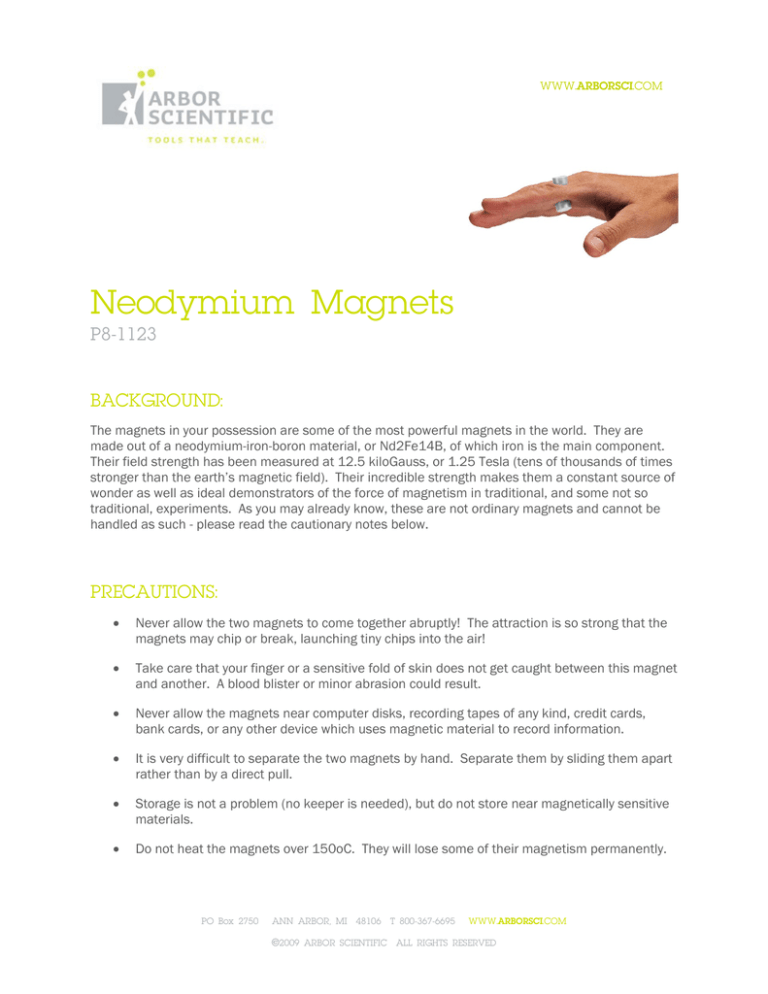
WWW.ARBORSCI.COM
Neodymium Magnets
P8-1123
BACKGROUND:
The magnets in your possession are some of the most powerful magnets in the world. They are
made out of a neodymium-iron-boron material, or Nd2Fe14B, of which iron is the main component.
Their field strength has been measured at 12.5 kiloGauss, or 1.25 Tesla (tens of thousands of times
stronger than the earth’s magnetic field). Their incredible strength makes them a constant source of
wonder as well as ideal demonstrators of the force of magnetism in traditional, and some not so
traditional, experiments. As you may already know, these are not ordinary magnets and cannot be
handled as such - please read the cautionary notes below.
PRECAUTIONS:
Never allow the two magnets to come together abruptly! The attraction is so strong that the
magnets may chip or break, launching tiny chips into the air!
Take care that your finger or a sensitive fold of skin does not get caught between this magnet
and another. A blood blister or minor abrasion could result.
Never allow the magnets near computer disks, recording tapes of any kind, credit cards,
bank cards, or any other device which uses magnetic material to record information.
It is very difficult to separate the two magnets by hand. Separate them by sliding them apart
rather than by a direct pull.
Storage is not a problem (no keeper is needed), but do not store near magnetically sensitive
materials.
Do not heat the magnets over 150oC. They will lose some of their magnetism permanently.
PO Box 2750
ANN ARBOR, MI 48106 T 800-367-6695
WWW.ARBORSCI.COM
©2009 ARBOR SCIENTIFIC ALL RIGHTS RESERVED
ACTIVITIES:
Place one of the magnets on the back of your hand and the other on your palm. The attraction is
strong enough to prevent either magnet from falling. Turn your hand palm-side downward and turn
over the lower magnet. Reversing field will repel the upper magnet, making it turn over as well. Take
care that the two magnets do not seek each other out around the edge of your hand!
1. Test the magnet on substances you “know” are not magnetic-pencils, crayons, aluminum foil,
bits of clay, paper, and anything else you can think of. See what happens when one of the
magnets is brought close to a dollar bill. Can you think of a way to determine whether the
attraction is from the printing ink or the paper itself? Could you if it weren’t your dollar?
2. Obtain a straight copper tube 3/4 inch in diameter and about 2-3 feet in length. Holding the
tube vertically, observe the magnet drop through the tube. Then try it with 2 joined magnets.
Can you explain the resulting phenomenon? (Hint: remember Hans Oersted’s discovery of
1820 and what Joseph Henry and Michael Faraday independently demonstrated in 1832.
Lenz’s law is most often referred to in context of this experiment.)
3. Gently roll a magnet across a wooden table. It should align itself with the earth’s magnetic
field.
4. Test the “lead” (graphite) of a mechanical pencil for magnetism. Balance the lead on a nonmagnetic item and observe whether the lead is attracted or repelled by the magnet.
5. Move the magnet across a plate of aluminum. Vary the speed and force you apply to the
magnet. The opposing force will amaze everyone. Next, try rolling the magnet down the
plate at an incline. What happens when it reaches the edge?
6. Set up a rotating balance apparatus. A pin mounted on the center of a wire (try a section of
coat hanger) works well. Then balance the point of the pin on top of an upside down cup so
that the “arms” (the wire) can rotate around the pivot. Pull the ends of the wire down below
the pivot point so that the center of gravity makes it easier to balance. Test for
“diamagnetism” in food. Stick a grape on each end of the wire (more balancing may be
required). Use both magnets stacked to repel the grapes (the balance will rotate.) Notice
that both poles repel the grapes.
PO Box 2750
ANN ARBOR, MI 48106 T 800-367-6695
WWW.ARBORSCI.COM
©2009 ARBOR SCIENTIFIC ALL RIGHTS RESERVED


